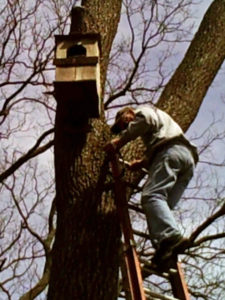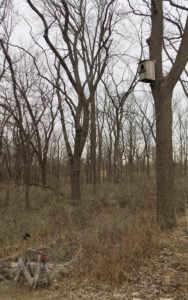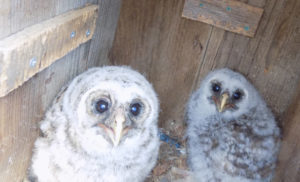The Owls and I
Last summer I was excited when a friend gave me an owl house. Although I have built and maintained houses for wood ducks, bluebirds, kestrels, house wrens, and a floating platform for a goose nest, the owl house would be a first. And I thought perhaps this would be a great opportunity to observe owl culture and get some photographs.
Our backyard is bordered by a mature woods and we have seen and heard barred owls there. I thought this location seemed appropriate for an owl house, and I placed it in a tree near our house. No brief task, the box is the size of a small dog house and it needed to be 20 to 50 feet above the ground. I used a pulley and a rope to haul it into place, just 20 feet up the truck of a large walnut tree. That’s about as high as I wanted to climb, and I wanted to be able to photograph a nest without risking life and limb.

The squirrels found the house immediately. They took turns dragging in leaves and other “soft” trash. No worries – if the owls want the site (unlike kestrels who will not use a squirrel contaminated house) the owls will chase the squirrels away – or just eat them. One morning late in winter, my wife announced, “I just saw a squirrel stop at the entrance of the owl house, look in and run away.” That was our clue. There might be an owl in residence. I put up the ladder and climbed to the box.
I wanted to be as unobtrusive as possible, so stayed to the side of the box and held a small mirror up to the opening – BAM! – out flew a barred owl. My reflexes nearly took me off the ladder.
I set up a critter-cam under the tree and a spotting scope on our back porch. The next phase of the story began.
The critter-cam’s shutter speed is a little slow to get great pics of the owls and the night-time photos are mostly tail feathers.
The camera did log each visit to the box, which was at regular 45 to 60 minute intervals all night, and with less frequency during the day. During the next couple of weeks the male brought food to the house. Once I thought I recognized a mouse or vole in his beak.
 Many snakes were consumed.
Many snakes were consumed.
Twice we saw the male making a purring sound while sitting on a nearby limb with a snake. The female flew to him and took the snakes. She took one away into the woods and the other she took directly back into the box. All of the other times we have seen the owls with food it has been a large red ragged piece of meat, too big to be a rodent. I’d guess it was rabbit or squirrel parts.
As time passed we noticed that both owls were bringing food to the box. It was time to put up the ladder and have a look. I waited until we were sure both adults were away. I took one picture and saw one of the adults headed my way. They can be vigorous when defending their nest. I didn’t want to harass them or risk losing an ear and I departed with haste.
Barred owls incubate their eggs as soon as they are hatched, so the owlets are born at different times. These two look to be about a week apart.
Another couple of weeks and we noticed activity in the box opening – wing flapping and a little head peeking out. # 1 owlet fledged early on May first.

Although it is called fledging the owlets don’t fly – they move by using their beaks and talons and wings in an action called ‘branching.’ I watched this one scurry up a limb, almost as fast as a squirrel.
The next morning the owlet was in a tree near the owl house waiting for breakfast.
The adults continue feeding the owlets for about 3 weeks.
As of this writing, we are waiting for #2 owlet to fledge. It won’t be long, he is flexing his wings and spending more time each day looking out at the world.
Resource: www.birds.cornell.edu
What I’ve found with all of my bird house projects is that it’s a great way to engage with nature. Try it and share your own stories!
Tags: barred owls, John Tiffany, owl house, photography

